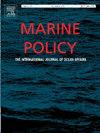利益相关者对尼日利亚西南部沿海地区海水养殖发展现状和首选方法的看法
IF 3.7
2区 社会学
Q2 ENVIRONMENTAL STUDIES
引用次数: 0
摘要
尼日利亚广阔的海岸线具有极好的水产养殖潜力,但仍未得到充分利用。本研究考察了利益相关者对尼日利亚西南部沿海活动现状的看法及其对海水养殖发展的偏好。该研究收集了来自实地观察、关键信息者访谈以及与翁多州、奥贡州和拉各斯州六个沿海地方政府地区的利益攸关方焦点小组讨论的数据,这些利益攸关方代表了私营和公共部门。采用描述性统计和专题内容分析对数据进行分析。调查结果表明,沿海活动仅限于淡水鱼类的养殖、一些咸淡水物种的野生捕捞和水体中的手工捕捞。其中,有100 %和75 %的回答者养殖最多的鱼是克拉丽鱼(Clarias gariepinus)和尼罗鱼(Oreochromis niloticus)。由于技术知识不足(x ā = 3.84),获得鱼类种子(x ā = 3.86)和饲料(x ā = 4.59)的途径有限,以及缺乏推广(x ā = 3.82)和信贷服务(x ā = 4.55),缺乏海洋鳍鱼、贝类和海藻的养殖。尽管存在这些挑战,利益攸关方仍确定了发展海水养殖的机会,包括提供野生鳍鱼鱼种(86% %)和亲鱼(55% %)、诱导繁殖的孵化场设施(64% %)和适应性强的鱼类饲料(68% %)。受访者更倾向于在咸淡水(41% %)和潮汐池(28% %)养殖,而不是在近海安装海笼(10% %)。该研究表明,尼日利亚的海水养殖发展可以针对半咸淡水物种进行调整,因为其中一些物种具有技术专长,它们的受欢迎程度和普遍可接受性。本文章由计算机程序翻译,如有差异,请以英文原文为准。
Stakeholders' perspective on current status and preferred approaches to mariculture development in coastal areas of Southwest Nigeria
Nigeria’s extensive coastline holds excellent potential for aquaculture but remains underutilized. This study examines stakeholders' perspectives on the current status of coastal activities and their preferences for mariculture development in southwest Nigeria. The study gathered data from field observations, key informant interviews, and focus group discussions with stakeholders from the six coastal Local Government Areas in Ondo, Ogun, and Lagos states, representing both the private and public sectors. Descriptive statistics and thematic content analysis were employed to analyze the data. The findings revealed that coastal activities were limited to the culture of freshwater finfish, the wild recruitment of some brackish-water species, and artisanal fishing in the water bodies. Specifically, Clarias gariepinus and Oreochromis niloticus were the most cultured fish by 100 % and 75 % of the respondents, respectively. The farming of marine finfish, shellfish, and seaweeds is lacking due to insufficient technical knowledge (x̄ = 3.84), limited access to fish seeds (x̄ = 3.86) and feeds (x̄ = 4.59), and the absence of extension (x̄ = 3.82) and credit services (x̄ = 4.55). Despite these challenges, stakeholders identified opportunities for mariculture development, including the availability of wild finfish fingerlings (86 %) and broodstocks (55 %), hatchery facilities for induced propagation (64 %), and adaptable fish feeds (68 %). The respondents would prefer farming in brackish waters (41 %) and tidal ponds (28 %) to offshore sea cage installation (10 %). The study suggests that mariculture development in Nigeria could be tailored towards brackish species due to the availability of technical expertise on some of these species, their popularity, and general acceptability.
求助全文
通过发布文献求助,成功后即可免费获取论文全文。
去求助
来源期刊

Marine Policy
Multiple-
CiteScore
7.60
自引率
13.20%
发文量
428
期刊介绍:
Marine Policy is the leading journal of ocean policy studies. It offers researchers, analysts and policy makers a unique combination of analyses in the principal social science disciplines relevant to the formulation of marine policy. Major articles are contributed by specialists in marine affairs, including marine economists and marine resource managers, political scientists, marine scientists, international lawyers, geographers and anthropologists. Drawing on their expertise and research, the journal covers: international, regional and national marine policies; institutional arrangements for the management and regulation of marine activities, including fisheries and shipping; conflict resolution; marine pollution and environment; conservation and use of marine resources. Regular features of Marine Policy include research reports, conference reports and reports on current developments to keep readers up-to-date with the latest developments and research in ocean affairs.
 求助内容:
求助内容: 应助结果提醒方式:
应助结果提醒方式:


